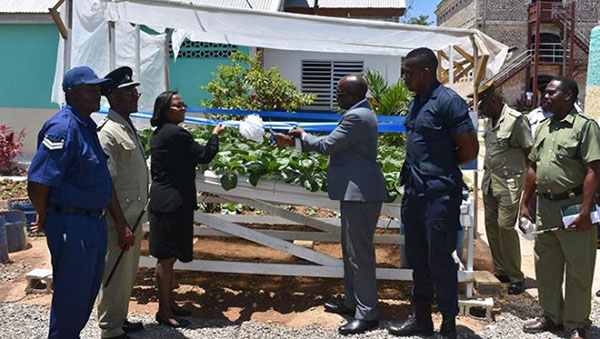KINGSTON, Jamaica, March 28, 2018 (CMC) – Jamaican authorities say there has been a significant reduction in the number of persons, being held in overcrowded conditions at correctional institutions, across the island.
The Ministry of National Security says the reclassification program, being managed by the Department of Correctional Services (DCS), involves shifting low-risk inmates from overcrowded facilities to others that are under capacity.
It said inmates are assessed when they are admitted to either Fort Augusta Adult Correctional Centre, Tower Street Adult Correctional Centre or St. Catherine Adult Correctional Centre, which act as reception centres, and sent to the appropriate institution, based on risk level.
The objective is to restructure and rationalise the inmate population to ensure greater efficiency in operations, improve conditions for inmates, and strengthen systems of rehabilitation.
Former State Minister in the Ministry of National Security, Senator Pearnel Charles Jr., explains that inmates are evaluated as part of the administrative process, to establish whether they are low-risk, medium-risk or high-risk offenders, which plays a key role in determining whether they should be transferred to low-, medium- or maximum-security correctional centres.
He says that most institutions are operating within capacity, such as the St. Catherine Adult Correctional Centre, which is within its ideal population parameters, of 850 inmates from a total of 936 inmates, in March 2016.
There are other prison facilities that are under-populated, such as Tamarind Farm Adult Correctional Centre in St. Catherine, which has about 200 inmates but has capacity for about 380; Richmond Farm Adult Correctional Centre in St. Mary has capacity for about 250 but has a population of approximately 160; and the Horizon Adult Remand Centre in Kingston has 800 inmates but can accommodate 1,000.
The population at the maximum-security Tower Street Adult Correctional Centre in Kingston has been reduced from 1,580 inmates as at January 19, 2017, to 1,453 as at March 8, 2018, and remains the only institution operating above its ideal population parameters.
However, the addition of a new 300-man block at Tamarind Farm, which houses medium-risk offenders, will provide more space for transfers from Tower Street and the St. Catherine Adult Correctional Centre.
“The new block at Tamarind Farm is now complete. The security lights have been installed, bathrooms are ready, and the kitchen is completed, as well as the landscaping. The official opening will be announced in short order,” said Charles Jr., who was shifted to the Ministry of Foreign Affairs and Foreign Trade in the Cabinet re-shuffle announced by Prime Minister Andrew Holness on Monday.
Meanwhile, the Ministry of National Security said it is seeking to introduce the use of electronic monitoring, as part of strategies to reduce the inmate population.
Eleven low-risk inmates participated in an Electronic Tagging and Monitoring Pilot Project, where they were able to serve the remainder of their sentences within their communities, while being electronically monitored.
The pilot was conducted to assess the use of electronic monitoring devices for low-risk offenders, and to move towards fully integrating these devices into the custodial process.
“We have made positive strides. With the advent of the use of electronic monitoring, there is even greater opportunity to reduce the burden of overcrowding and promote the success of effective reintegration,” Charles Jr. said, commending the successes, to date, to the hard-working officers and staff of the DCS.
He notes that the reclassification exercise also helped the DCS to pick up cases that were dormant or unmentioned in court due to lack of representation for the inmates.
For her part, Director of the Inspectorate Unit at the Ministry, Anne Tinglin, told JIS News that there is a reclassification committee overseeing the rationalisation process, which, in addition to the Inspectorate, comprises Superintendents of the respective institutions, members of the clergy, social workers, and the DCS’ Director of Security.
She explained that the criteria for transfer include inmates’ medical results, whether or not the inmate has been engaged in effective rehabilitation activities, which would improve their status from high-risk to low-risk, and their behavioural patterns.
“The inmates that come before the committee are pre-selected by the senior staff of the respective institutions, based on specific parameters of suitability for transfer,” she noted.
According to Tinglin, 83 percent of all inmates, who were considered for reclassification, were transferred.
She observed that 92 percent of inmates from the Tower Street facility; 81 percent from the St. Catherine Adult Correctional Centre; and 71 percent from Tamarind Farm were given the opportunity to be a part of the exercise.
The inmate reclassification program is in keeping with the ‘Reducing Re-Offending’ component of the Ministry’s five-pillar crime-fighting strategy.
 Pride News Canada's Leader In African Canadian & Caribbean News, Views & Lifestyle
Pride News Canada's Leader In African Canadian & Caribbean News, Views & Lifestyle





